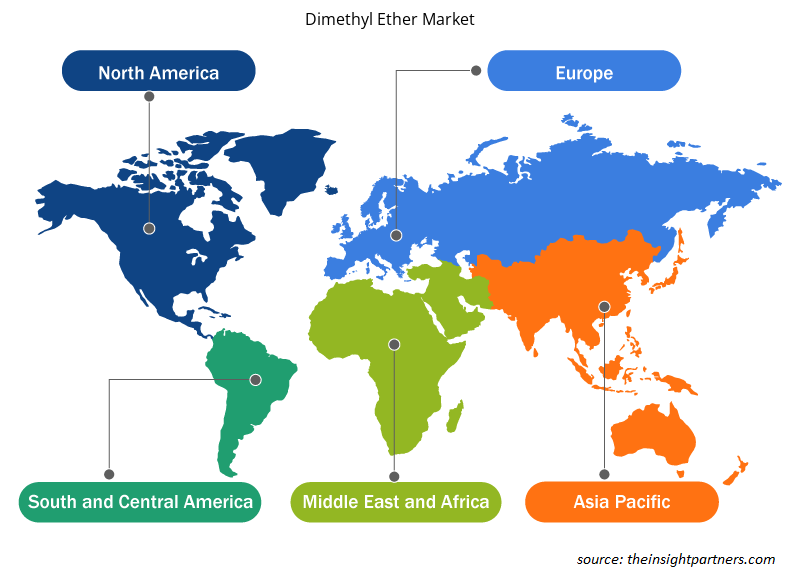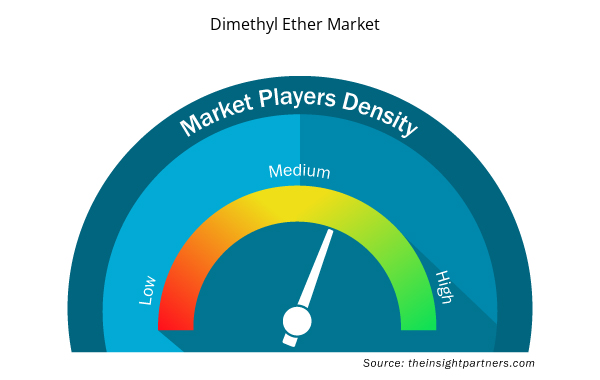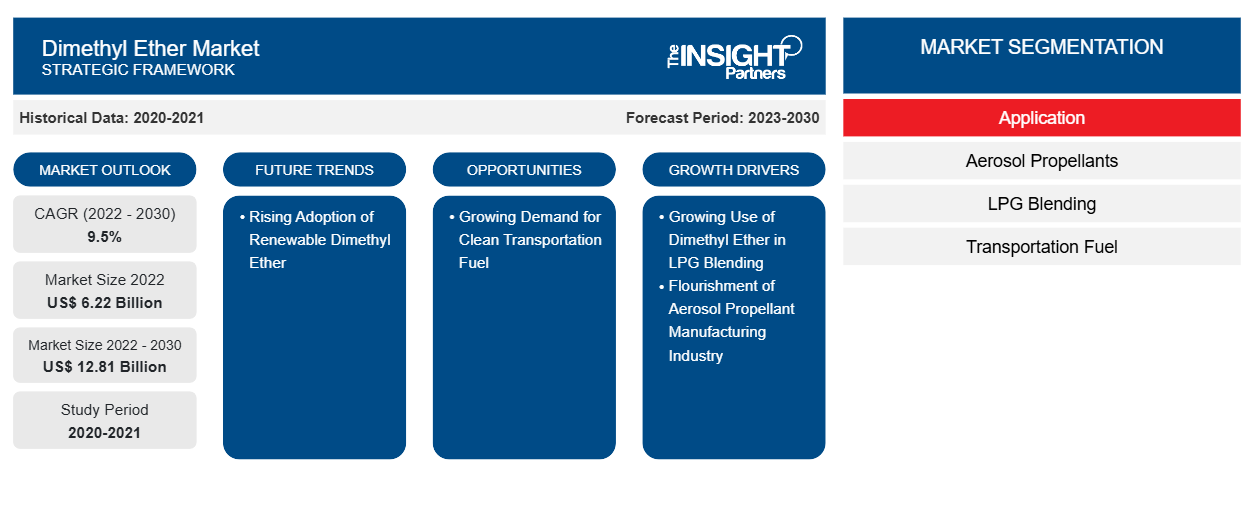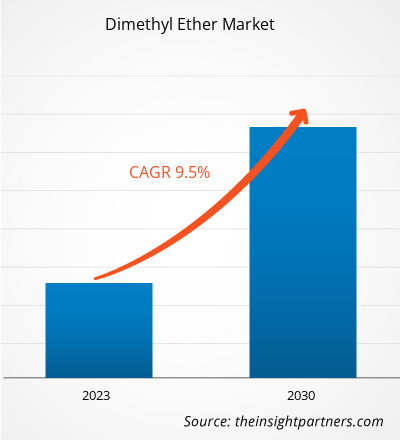[Forschungsbericht] Der Markt für Dimethylether wurde im Jahr 2022 auf 6.216,45 Millionen US-Dollar geschätzt und soll bis 2030 12.808,32 Millionen US-Dollar erreichen; von 2022 bis 2030 wird eine durchschnittliche jährliche Wachstumsrate (CAGR) von 9,5 % erwartet.dimethyl ether market size was valued at US$ 6,216.45 million in 2022 and is expected to reach US$ 12,808.32 million by 2030; it is estimated to register a CAGR of 9.5% from 2022 to 2030.
Markteinblicke und Analystenansichten:
Dimethylether ist bei Raumtemperatur und -druck ein farbloses, brennbares Gas. Es wird hauptsächlich als Treibmittel in Aerosolsprays und als Mischkomponente in Flüssiggas verwendet. Der ether is a colorless, flammable gas at room temperature and pressure. It is primarily used as a propellant in aerosol spray and as a blending component in LPG. The Dimethylether-Markt ether market hat in den letzten Jahren aufgrund seiner vielseitigen Anwendungsmöglichkeiten und umweltfreundlichen Eigenschaften erhebliche Veränderungen erfahren. Als Reaktion auf globale Bedenken hinsichtlich der Luftqualität und der Treibhausgasemissionen hat sich Dimethylether als vielversprechender Kandidat für den Ersatz von herkömmlichem Dieselkraftstoff herausgestellt. Dieser Wandel findet insbesondere in Regionen statt, in denen die Reduzierung der Emissionen von Dieselmotoren oberste Priorität hat. Bei der Verbrennung erzeugt Dimethylether deutlich weniger Emissionen, insbesondere an Feinstaub, als herkömmliche Dieselkraftstoffe. Infolgedessen hat Dimethylether als sauberer brennende Kraftstoffoption Aufmerksamkeit erregt, die mit Nachhaltigkeitszielen und gesetzlichen Anforderungen in Einklang steht. Darüber hinaus kann Dimethylether aus einer Vielzahl von Rohstoffen hergestellt werden, darunter Erdgas, Kohle und Biomasse. Diese Anpassungsfähigkeit der Rohstoffquellen erhöht seine Attraktivität als erneuerbare und nachhaltige Energielösung und wird voraussichtlich das Wachstum des Dimethylether-Marktes vorantreiben.dimethyl ether has emerged as a promising candidate to replace traditional diesel fuel. This shift is particularly in regions where reducing emissions from diesel engines is a top priority. When burned, dimethyl ether produces significantly fewer emissions, particularly in particulate matter, than conventional diesel fuels. As a result, dimethyl ether has garnered attention as a cleaner-burning fuel option that aligns with sustainability goals and regulatory requirements. Moreover, dimethyl ether can be produced from a variety of feedstocks, including natural gas, coal, and biomass. This adaptability in feedstock sources enhances its appeal as a renewable and sustainable energy solution and is expected to drive the dimethyl ether market growth.
Wachstumstreiber und Herausforderungen:
Die Kompatibilität von DME und LPG macht das Mischen zu einem nahtlosen Prozess. DME hat ähnliche physikalische Eigenschaften wie LPG, z. B. ist es bei Raumtemperatur gasförmig und lässt sich unter mäßigem Druck leicht verflüssigen. Diese Kompatibilität stellt sicher, dass DME-LPG-Gemische unter Verwendung der vorhandenen LPG-Infrastruktur wie Lagertanks, Vertriebsnetzen und Tankstellen gelagert, transportiert und abgegeben werden können. Dieser Aspekt senkt die Markteintrittsbarrieren für die Einführung von DME-LPG-Gemischen erheblich und ermöglicht eine schnellere Integration in bestehende Energiesysteme. DME-LPG-Gemische bieten eine Übergangslösung, da Industrie und Regierungen versuchen, ihre Energiequellen zu diversifizieren und die Abhängigkeit von traditionellen fossilen Brennstoffen zu verringern. Das zunehmende Bewusstsein für die Vorteile von DME-LPG-Gemischen fördert eine nachhaltigere und effizientere Energielandschaft und treibt so das Wachstum des Dimethylether-Marktes voran.DME and LPG makes blending a seamless process. DME has similar physical properties to LPG, such as being gaseous at room temperature and readily liquified under moderate pressure. This compatibility ensures that DME-LPG blends can be stored, transported, and dispensed using existing LPG infrastructure, such as storage tanks, distribution networks, and refueling stations. This aspect significantly lowers the barriers to entry for adopting DME-LPG blends and enables more rapid integration into existing energy systems. DME-LPG blends offer a transitional solution as industries and governments seek to diversify their energy sources and reduce dependency on traditional fossil fuels. The increasing awareness regarding the advantages of DME-LPG blends promotes a more sustainable and efficient energy landscape, thereby driving the dimethyl ether market growth.
Das Vorhandensein potenzieller Ersatzstoffe wie komprimiertes Erdgas (CNG) und Ethanol könnte das Marktwachstum von Dimethylether jedoch begrenzen. Aufgrund seines geringeren Emissionsprofils wird CNG im Transportsektor häufig als Alternative zu herkömmlichem Benzin und Dieselkraftstoff verwendet. Wie DME weist CNG im Vergleich zu herkömmlichen fossilen Brennstoffen geringere Treibhausgasemissionen und Luftschadstoffe auf. Diese Überschneidung der Vorteile könnte zu einem Wettbewerb zwischen DME und CNG führen, insbesondere in Regionen mit gut entwickelter CNG-Infrastruktur. Darüber hinaus ist Ethanol ein weiterer Ersatzstoff, der den Dimethylether-Markt beeinflussen könnte, insbesondere im Hinblick auf seine Verwendung als alternativer Kraftstoff und Sauerstoffanreicherung in Benzin. Ethanol aus erneuerbaren Quellen wie Biomasse und landwirtschaftlichen Rohstoffen hat als sauberer alternativer Kraftstoff an Aufmerksamkeit gewonnen. Daher könnte die Verfügbarkeit von Ersatzprodukten das Marktwachstum von Dimethylether negativ beeinflussen.CNG) and ethanol could limit the dimethyl ether market growth. Due to its lower emissions profile, CNG is extensively used as an alternative to conventional gasoline and diesel fuels in the transportation sector. Like DME, CNG offers reduced greenhouse gas emissions and air pollutants compared to traditional fossil fuels. This overlap in benefits could lead to competition between DME and CNG, especially in regions with well-developed CNG infrastructure. In addition, ethanol is another substitute that could impact the dimethyl ether market, particularly in terms of its use as an alternative fuel and oxygenate in gasoline. Ethanol derived from renewable sources, such as biomass and agricultural feedstocks, has gained attention as a cleaner alternative fuel. Therefore, the availability of substitute products could negatively impact the dimethyl ether market growth.
Passen Sie diesen Bericht Ihren Anforderungen an
Sie erhalten kostenlose Anpassungen an jedem Bericht, einschließlich Teilen dieses Berichts oder einer Analyse auf Länderebene, eines Excel-Datenpakets sowie tolle Angebote und Rabatte für Start-ups und Universitäten.
- Holen Sie sich die wichtigsten Markttrends aus diesem Bericht.Dieses KOSTENLOSE Beispiel umfasst eine Datenanalyse von Markttrends bis hin zu Schätzungen und Prognosen.
Berichtssegmentierung und -umfang:
Der globale Dimethylether-Markt ist nach Anwendung und Geografie segmentiert. Basierend auf der Anwendung ist der Dimethylether-Markt in Aerosol-Treibmittel, LPG-Mischung, Transportkraftstoff, Kraftstoff zur Stromerzeugung, chemische Rohstoffe und andere unterteilt. Geografisch ist der Dimethylether-Markt in Nordamerika (USA, Kanada und Mexiko), Europa (Deutschland, Frankreich, Italien, Großbritannien, Russland und der Rest von Europa), Asien-Pazifik (Australien, China, Japan, Indien, Südkorea und der Rest von Asien-Pazifik), den Nahen Osten und Afrika (Südafrika, Saudi-Arabien, die Vereinigten Arabischen Emirate und der Rest von Nahem Osten und Afrika) und Süd- und Mittelamerika (Brasilien, Argentinien und der Rest von Süd- und Mittelamerika) segmentiert.
Segmentanalyse:
Basierend auf der Anwendung ist der Dimethylether-Markt in Aerosol-Treibmittel, LPG-Mischungen, Transportkraftstoffe, Kraftstoffe zur Stromerzeugung, chemische Rohstoffe und andere unterteilt. Das Segment der Transportkraftstoffe wird voraussichtlich von 2022 bis 2030 ein erhebliches Wachstum verzeichnen. Da Regierungen, Industrien und Verbraucher weltweit der ökologischen Nachhaltigkeit zunehmend Priorität einräumen und nach Alternativen zu herkömmlichen fossilen Brennstoffen suchen, erweist sich DME aufgrund seiner einzigartigen Eigenschaften und seiner Kompatibilität mit den Anforderungen an saubere Transportmittel als vielversprechender Kandidat. Einer der Haupttreiber hinter der Nachfrage nach sauberen Transportkraftstoffen ist die dringende Notwendigkeit, Treibhausgasemissionen und Luftschadstoffe zu verringern. Herkömmliche Dieselkraftstoffe tragen zur Luftverschmutzung bei und sind eine erhebliche Quelle von Kohlendioxidemissionen . DME hingegen bietet mehrere Umweltvorteile. Es erzeugt weniger Partikelemissionen, Schwefeldioxid und Stickoxide als herkömmliche Kohlendioxidemissionsquellen. DME hingegen bietet mehrere Umweltvorteile. Es erzeugt weniger Partikelemissionen, Schwefeldioxid und Stickoxide als herkömmlicher Diesel. Darüber hinaus erzeugt die Verbrennung von DME weniger Treibhausgase und trägt so zu einer saubereren Luftqualität und einer nachhaltigeren Zukunft bei. Saubere Kraftstoffe wie DME passen gut zu den globalen Bemühungen, die in internationalen Abkommen wie dem Pariser Abkommen festgelegten Emissionsreduktionsziele zu erreichen. Regierungen setzen strengere Vorschriften zur Reduzierung der Fahrzeugemissionen um und schaffen so ein günstiges Umfeld für die Einführung sauberer Kraftstoffe. Da DME mit minimalen Modifikationen problemlos in bestehende Dieselmotoren integriert werden kann, stellt es eine attraktive Lösung für Branchen dar, die eine sofortige Emissionsreduzierung mit umfangreichen Infrastrukturänderungen anstreben. All diese Faktoren treiben das Wachstum des Kraftstoffsegments im Dimethylethermarkt voran.dimethyl ether market is segmented into aerosol propellants, LPG blending, transportation fuel, power generation fuel, chemical feedstock, and others. The transportation fuel segment is expected to register significant growth from 2022 to 2030. As governments, industries, and consumers worldwide increasingly prioritize environmental sustainability and seek alternatives to conventional fossil fuels, DME emerges as a promising candidate due to its unique properties and compatibility with clean transportation needs. One of the key drivers behind the demand for clean transportation fuels is the urgent requirement to lessen greenhouse gas emissions and air pollutants. Conventional diesel fuels contribute to air pollution and are a considerable source of DME, on the other hand, offers several environmental advantages. It produces lower particulate matter emissions, DME, on the other hand, offers several environmental advantages. It produces lower particulate matter emissions, sulfur dioxide, and nitrogen oxides than traditional diesel. Moreover, DME combustion generates fewer greenhouse gases, contributing to cleaner air quality and a more sustainable future. Clean transportation fuels such as DME align well with the global push to meet emission reduction targets defined in international agreements such as the Paris Agreement. Governments are implementing stricter regulations to curb vehicle emissions, providing a favorable environment for the adoption of cleaner fuels. As DME can be easily integrated into existing diesel engines with minimal modifications, it provides an attractive solution for industries seeking immediate emissions reduction with extensive infrastructural changes. All these factors are driving the growth of the transportation fuel segment in the dimethyl ether market.
Regionale Analyse:
Geografisch ist der Dimethylether-Markt in fünf Hauptregionen unterteilt: Nordamerika, Europa, Asien-Pazifik, Süd- und Mittelamerika sowie Naher Osten und Afrika. Der Wert des Asien-Pazifik-Raums wurde im Jahr 2022 auf rund 1.000 Millionen US-Dollar geschätzt. Die Region hat sich zu einem globalen Produktionszentrum mit Branchen wie Chemikalien, Flüssiggas, Aerosol-Treibmittel und Stromerzeugung entwickelt. Der Fokus der Regierung auf den Ersatz traditioneller Brennstoffquellen durch alternative Quellen kann potenzielle Chancen auf dem Dimethylether-Markt bieten. Daher wird erwartet, dass die Nachfrage nach Dimethylether mit dem Fortschreiten und der Industrialisierung der Region stark bleibt, was das Wachstum des Dimethylether-Marktes im Asien-Pazifik-Raum von 2022 bis 2030 ankurbeln wird. Europa wird voraussichtlich von 2022 bis 2030 eine durchschnittliche jährliche Wachstumsrate von etwa 9 % verzeichnen. Europas Nachhaltigkeitsziele und der Übergang zu sauberen Energiequellen haben die Hersteller dazu veranlasst, DME aus erneuerbaren Rohstoffen herzustellen. Im Jahr 2021 erhielten SHV Energy und UGI International von der Europäischen Kommission die Genehmigung zur Gründung eines Joint Ventures zur Herstellung und Nutzung von erneuerbarem Dimethylether. All diese Faktoren treiben das Wachstum des Dimethylether-Marktes in Europa voran. Darüber hinaus wird für Nordamerika ein Wert von rund 4.000 Millionen US-Dollar im Jahr 2030 prognostiziert.
Branchenentwicklungen und zukünftige Chancen:
Nachfolgend sind verschiedene Initiativen der wichtigsten Akteure auf dem Dimethylether-Markt aufgeführt:
- Im Januar 2021 nahm Mitsubishi Corp den kommerziellen Betrieb seiner Methanol- und Dimethylether-Anlage (DME) in Trinidad und Tobago auf. Die Anlage hat eine jährliche Produktionskapazität von 1 Million Tonnen Methanol und 20.000 Tonnen DME. Die Anlage nahm am 18. Dezember 2020 den kommerziellen Betrieb auf. Die Anlage wird von Caribbean Gas Chemical Ltd (CGCL) betrieben.
- Im Mai 2021 begann Oberon Fuels, Hersteller von sauber verbrennendem Dimethylether (DME)-Transportkraftstoff, mit der Produktion des erneuerbaren DME (rDME) in den USA, der derzeit einzigen kommerziellen Produktion.
Regionale Einblicke in den Dimethylether-Markt
Die regionalen Trends und Faktoren, die den Dimethylether-Markt im Prognosezeitraum beeinflussen, wurden von den Analysten von Insight Partners ausführlich erläutert. In diesem Abschnitt werden auch die Marktsegmente und die Geografie des Dimethylether-Marktes in Nordamerika, Europa, im asiatisch-pazifischen Raum, im Nahen Osten und Afrika sowie in Süd- und Mittelamerika erörtert.

- Erhalten Sie regionale Daten zum Dimethylether-Markt
Umfang des Marktberichts zu Dimethylether
| Berichtsattribut | Details |
|---|---|
| Marktgröße im Jahr 2022 | 6,22 Milliarden US-Dollar |
| Marktgröße bis 2030 | 12,81 Milliarden US-Dollar |
| Globale CAGR (2022 - 2030) | 9,5 % |
| Historische Daten | 2020-2021 |
| Prognosezeitraum | 2023–2030 |
| Abgedeckte Segmente | Nach Anwendung
|
| Abgedeckte Regionen und Länder | Nordamerika
|
| Marktführer und wichtige Unternehmensprofile |
|
Marktteilnehmerdichte für Dimethylether: Auswirkungen auf die Geschäftsdynamik verstehen
Der Markt für Dimethylether wächst rasant, angetrieben durch die steigende Nachfrage der Endverbraucher aufgrund von Faktoren wie sich entwickelnden Verbraucherpräferenzen, technologischen Fortschritten und einem größeren Bewusstsein für die Vorteile des Produkts. Mit steigender Nachfrage erweitern Unternehmen ihr Angebot, entwickeln Innovationen, um die Bedürfnisse der Verbraucher zu erfüllen, und nutzen neue Trends, was das Marktwachstum weiter ankurbelt.
Die Marktteilnehmerdichte bezieht sich auf die Verteilung der Firmen oder Unternehmen, die in einem bestimmten Markt oder einer bestimmten Branche tätig sind. Sie gibt an, wie viele Wettbewerber (Marktteilnehmer) in einem bestimmten Marktraum im Verhältnis zu seiner Größe oder seinem gesamten Marktwert präsent sind.
Die wichtigsten auf dem Dimethylether-Markt tätigen Unternehmen sind:
- Nouryon Chemicals Holding BV
- Shell Plc
- Mitsubishi Gas Chemical Co Inc
- Die Chemours Co
- Aerosolex
Haftungsausschluss : Die oben aufgeführten Unternehmen sind nicht in einer bestimmten Reihenfolge aufgeführt.

- Überblick über die wichtigsten Akteure auf dem Dimethylether-Markt
Auswirkungen von COVID-19:
Die COVID-19-Pandemie hat sich in fast allen Branchen in verschiedenen Ländern negativ ausgewirkt. Lockdowns, Reisebeschränkungen und Betriebsschließungen in Nordamerika, Europa, Asien-Pazifik (APAC), Süd- und Mittelamerika sowie dem Nahen Osten und Afrika (MEA) behinderten das Wachstum mehrerer Branchen, darunter der Chemie- und Materialindustrie. Die Schließung von Produktionseinheiten von Dimethylether-Unternehmen störte globale Lieferketten, Fertigungsaktivitäten und Lieferpläne. Verschiedene Unternehmen meldeten Verzögerungen bei Produktlieferungen und einen Einbruch ihrer Produktverkäufe im Jahr 2020. Die meisten industriellen Produktionsanlagen wurden während der Pandemie geschlossen, was den Verbrauch von Dimethylether verringerte. Darüber hinaus hat die COVID-19-Pandemie Schwankungen bei den Dimethylether-Preisen verursacht. Mehrere Branchen haben jedoch ihren Betrieb wiederbelebt, nachdem die Lieferengpässe behoben waren, was zu einer Wiederbelebung des Dimethylether-Marktes führte. Darüber hinaus fördert die steigende Nachfrage nach Dimethylether aus den Anwendungsbereichen LPG-Mischung, Aerosol-Treibmittel und Chemikalien das Wachstum des Dimethylether-Marktes erheblich.
Wettbewerbslandschaft und Schlüsselunternehmen:
Nouryon Chemicals Holding BV, Shell Plc, Mitsubishi Gas Chemical Co Inc, The Chemours Co, Aerosolex, Oberon Fuels Inc, Merck KGaA, Jiangsu July Chemical Co Ltd, Sichuan Lutianhua Co Ltd und Grillo-Werke AG gehören zu den Akteuren auf dem globalen Dimethylether-Markt. Die Akteure auf dem globalen Dimethylether-Markt konzentrieren sich darauf, qualitativ hochwertige Produkte anzubieten, um die Kundennachfrage zu erfüllen.
- Historische Analyse (2 Jahre), Basisjahr, Prognose (7 Jahre) mit CAGR
- PEST- und SWOT-Analyse
- Marktgröße Wert/Volumen – Global, Regional, Land
- Branche und Wettbewerbsumfeld
- Excel-Datensatz


- Smart Grid Sensors Market
- Volumetric Video Market
- Non-Emergency Medical Transportation Market
- Investor ESG Software Market
- Lyophilization Services for Biopharmaceuticals Market
- Smart Parking Market
- UV Curing System Market
- Vertical Farming Crops Market
- Vaginal Specula Market
- Occupational Health Market

Report Coverage
Revenue forecast, Company Analysis, Industry landscape, Growth factors, and Trends

Segment Covered
This text is related
to segments covered.

Regional Scope
North America, Europe, Asia Pacific, Middle East & Africa, South & Central America

Country Scope
This text is related
to country scope.
Häufig gestellte Fragen
From 2022 to 2030, the Asia Pacific is expected to be the fastest-growing segment. The region has become a global manufacturing hub, with industries spanning chemicals, LPG, aerosol propellant, and power production. The government's focus on the replacement of traditional fuel sources with alternative sources can offer potential opportunities in the dimethyl ether market. Thus, as the region progresses and industrializes, the demand for dimethyl ether is expected to remain strong, which is expected to boost the dimethyl ether market growth in Asia Pacific from 2022 to 2030.
From 2022 to 2030, the transportation fuel is expected to be the fastest-growing segment. As governments, industries, and consumers worldwide increasingly prioritize environmental sustainability and seek alternatives to conventional fossil fuels, DME emerges as a promising candidate due to its unique properties and compatibility with clean transportation needs. These factors led to the dominance of the transportation fuel segment in 2022.
The global push for energy security and reduced reliance on fossil fuels also drives the adoption of dimethyl ether. As dimethyl ether can be produced locally from diverse feedstocks, it offers a degree of energy independence and resilience against supply disruption that can occur with traditional fuels subject to geopolitical factors. Government strategies to promote renewable energy and reduce emissions further accelerate the adoption of dimethyl ether. Financial incentives, grants, and mandates for incorporating renewable fuels into transportation fleets encourage industries to invest in dimethyl ether production and utilization. These factors are driving the dimethyl ether market growth.
The major players operating in the dimethyl ether market are Nouryon Chemicals Holding BV, Shell Plc, Mitsubishi Gas Chemical Co Inc, The Chemours Co, Aerosolex, Oberon Fuels Inc, Merck KGaA, Jiangsu July Chemical Co Ltd, Sichuan Lutianhua Co Ltd, and Grillo-Werke AG.
In 2022, North America accounted for the largest share of the global dimethyl ether market. The rising focus on research and development of dimethyl ether is favoring the market expansion in North America. The concerns about climate change, the need for clean transportation fuel, and the requirement for alternative fuel are a few factors led to the dominance of North America in 2022.
In 2022, the LPG blending segment held the largest market share. Dimethyl ether (DME)-LPG blends offer a transitional solution as industries and governments seek to diversify their energy sources and reduce dependency on traditional fossil fuels. The increasing awareness regarding the advantages of DME-LPG blends promotes a more sustainable and efficient energy landscape, that led to the dominance of the LPG blending segment in 2022.
Trends and growth analysis reports related to Chemicals and Materials : READ MORE..
The List of Companies - Dimethyl Ether Market
- Nouryon Chemicals Holding BV
- Shell Plc
- Mitsubishi Gas Chemical Co Inc
- The Chemours Co
- Aerosolex
- Oberon Fuels Inc
- Merck KGaA
- Jiangsu July Chemical Co Ltd
- Sichuan Lutianhua Co Ltd
- Grillo-Werke AG
The Insight Partners performs research in 4 major stages: Data Collection & Secondary Research, Primary Research, Data Analysis and Data Triangulation & Final Review.
- Data Collection and Secondary Research:
As a market research and consulting firm operating from a decade, we have published and advised several client across the globe. First step for any study will start with an assessment of currently available data and insights from existing reports. Further, historical and current market information is collected from Investor Presentations, Annual Reports, SEC Filings, etc., and other information related to company’s performance and market positioning are gathered from Paid Databases (Factiva, Hoovers, and Reuters) and various other publications available in public domain.
Several associations trade associates, technical forums, institutes, societies and organization are accessed to gain technical as well as market related insights through their publications such as research papers, blogs and press releases related to the studies are referred to get cues about the market. Further, white papers, journals, magazines, and other news articles published in last 3 years are scrutinized and analyzed to understand the current market trends.
- Primary Research:
The primarily interview analysis comprise of data obtained from industry participants interview and answers to survey questions gathered by in-house primary team.
For primary research, interviews are conducted with industry experts/CEOs/Marketing Managers/VPs/Subject Matter Experts from both demand and supply side to get a 360-degree view of the market. The primary team conducts several interviews based on the complexity of the markets to understand the various market trends and dynamics which makes research more credible and precise.
A typical research interview fulfils the following functions:
- Provides first-hand information on the market size, market trends, growth trends, competitive landscape, and outlook
- Validates and strengthens in-house secondary research findings
- Develops the analysis team’s expertise and market understanding
Primary research involves email interactions and telephone interviews for each market, category, segment, and sub-segment across geographies. The participants who typically take part in such a process include, but are not limited to:
- Industry participants: VPs, business development managers, market intelligence managers and national sales managers
- Outside experts: Valuation experts, research analysts and key opinion leaders specializing in the electronics and semiconductor industry.
Below is the breakup of our primary respondents by company, designation, and region:

Once we receive the confirmation from primary research sources or primary respondents, we finalize the base year market estimation and forecast the data as per the macroeconomic and microeconomic factors assessed during data collection.
- Data Analysis:
Once data is validated through both secondary as well as primary respondents, we finalize the market estimations by hypothesis formulation and factor analysis at regional and country level.
- Macro-Economic Factor Analysis:
We analyse macroeconomic indicators such the gross domestic product (GDP), increase in the demand for goods and services across industries, technological advancement, regional economic growth, governmental policies, the influence of COVID-19, PEST analysis, and other aspects. This analysis aids in setting benchmarks for various nations/regions and approximating market splits. Additionally, the general trend of the aforementioned components aid in determining the market's development possibilities.
- Country Level Data:
Various factors that are especially aligned to the country are taken into account to determine the market size for a certain area and country, including the presence of vendors, such as headquarters and offices, the country's GDP, demand patterns, and industry growth. To comprehend the market dynamics for the nation, a number of growth variables, inhibitors, application areas, and current market trends are researched. The aforementioned elements aid in determining the country's overall market's growth potential.
- Company Profile:
The “Table of Contents” is formulated by listing and analyzing more than 25 - 30 companies operating in the market ecosystem across geographies. However, we profile only 10 companies as a standard practice in our syndicate reports. These 10 companies comprise leading, emerging, and regional players. Nonetheless, our analysis is not restricted to the 10 listed companies, we also analyze other companies present in the market to develop a holistic view and understand the prevailing trends. The “Company Profiles” section in the report covers key facts, business description, products & services, financial information, SWOT analysis, and key developments. The financial information presented is extracted from the annual reports and official documents of the publicly listed companies. Upon collecting the information for the sections of respective companies, we verify them via various primary sources and then compile the data in respective company profiles. The company level information helps us in deriving the base number as well as in forecasting the market size.
- Developing Base Number:
Aggregation of sales statistics (2020-2022) and macro-economic factor, and other secondary and primary research insights are utilized to arrive at base number and related market shares for 2022. The data gaps are identified in this step and relevant market data is analyzed, collected from paid primary interviews or databases. On finalizing the base year market size, forecasts are developed on the basis of macro-economic, industry and market growth factors and company level analysis.
- Data Triangulation and Final Review:
The market findings and base year market size calculations are validated from supply as well as demand side. Demand side validations are based on macro-economic factor analysis and benchmarks for respective regions and countries. In case of supply side validations, revenues of major companies are estimated (in case not available) based on industry benchmark, approximate number of employees, product portfolio, and primary interviews revenues are gathered. Further revenue from target product/service segment is assessed to avoid overshooting of market statistics. In case of heavy deviations between supply and demand side values, all thes steps are repeated to achieve synchronization.
We follow an iterative model, wherein we share our research findings with Subject Matter Experts (SME’s) and Key Opinion Leaders (KOLs) until consensus view of the market is not formulated – this model negates any drastic deviation in the opinions of experts. Only validated and universally acceptable research findings are quoted in our reports.
We have important check points that we use to validate our research findings – which we call – data triangulation, where we validate the information, we generate from secondary sources with primary interviews and then we re-validate with our internal data bases and Subject matter experts. This comprehensive model enables us to deliver high quality, reliable data in shortest possible time.


 Holen Sie sich ein kostenloses Muster für diesen Bericht
Holen Sie sich ein kostenloses Muster für diesen Bericht